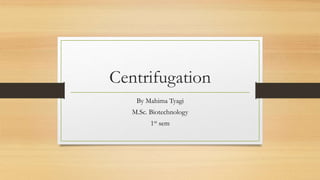
Centrifugation notes slideshare
- 1. Centrifugation By Mahima Tyagi M.Sc. Biotechnology 1st sem
- 2. CONTENT • Introduction of Centrifugation • History of Centrifugation • Principle of Centrifugation • Types of Centrifugation • Applications of Centrifugation • Reference
- 3. Introduction • What is centrifugation? • It is a technique which involves replication of centrifugal force to separate partical from a solution. • According to their size, shape, density, viscosity of the median and rotor speed . • What is centrifuge ? • A centrifuge is a device that uses centrifugal force to separate various components of a fluid. This is achieved by spinning the fluid at high speed within a container , thereby separating fluids of different densities ( eg. Cream from milk ) or liquid from solids .
- 4. Cont. • What is centrifugal force ? • The apparent force that is felt by an object moving in a curved path that acts outwardly away from the center of rotation.
- 6. History • In 1864, Antonin Prandtl ,who developed the first dairy centrifuge for the purpose of separating cream from milk. • In 1869, Miescher used a crude centrifuge system to isolate a cell organelles. • Svedberg in late 1920s developed first analytical ultracentrifugation . • Technical refinement of the preparative centrifugation technique by Claude and colleagues in 1940s .
- 7. Basic principle of Centrifugation • A centrifuge works by using the principle of sedimentation ( process of settling down) : under the influence of gravitational force ( g – force ) , substances separate according to their density. • Different types of separation are known including isopycnic, ultrafilteration, density gradient, phase separation , and pelleting.
- 8. Cont. • The rate of sedimentation depends upon applied centrifugal field being directed radiely outward and is determined by the formula G = w² r w = angular velocity of rotor rpm ( rotation per minute ) r = radial distance of particle from axis of rotation
- 9. Types of Centrifugation techniques • There are two types of centrifugal technique for separating particles : 1. Density gradient centrifugation 2. Differential Centrifugation
- 10. Density gradient centrifugation • Density gradient centrifugation is a technique in which macromolecules move through a density gradient until they find a density equal to their own. • Density gradient centrifugation can further be divided into rate zonal and isopycnic centrifugation .
- 11. Rate zonal centrifugation • In rate zonal centrifugation the solution have a density gradient. The sample has a density i.e greater than all the layers in the solution. • The sample is applied in a thin zone at the top of the centrifuge tube on a density gradient. Under centrifugation force, the particles will begin sedimenting through the gradient. • The particles will begin sedimenting in separate zones according to their size, shape and density.
- 12. Isopycnic centrifugation • In this type of Centrifugation, the solution contains a greater range of densities. • The density gradient contains the whole range of densities of the particles in the sample. • Each particle will sediment only to the position in the centrifuge tube at which the gradient density is equal to it’s own density. • In isopycnic centrifugation separation of particules occur into zones on the basis of their density differences, independent of time.
- 13. Differential Centrifugation • Differential centrifugation is a common procedure in microbiology and cytology used to separate certain organelles from whole cells for further analysis of specific parts of cells . • In the process, a tissue sample is first homogenized to break the cell membrane and mix up the cell contents. • The homogenate is then subjected to repeated centrifugations, each time removing the pellet and increasing the centrifugal force .
- 14. Applications • To separate two miscible substances. • To analyze the hydrodynamic properties of macromolecules. • Purification of mammalian cells. • Fractionation of subcellular organelles (including membranes/membrane fractions) Fractionation of membrane vesicles. • Separating chalk powder from water. • Removing fat from milk to produce skimmed milk. • Separating particles from an air-flow using cyclonic separation. • The clarification and stabilization of wine. • Separation of urine components and blood components in forensic and research laboratories. • Aids in the separation of proteins using purification techniques such as salting out, e.g. ammonium sulfate precipitation.
- 16. References • Principles and Techniques of biochemistry, Wilson and Walker, page no. 74-75, 86-87. • Slideshare/Sanjay Sinhwar, phd. Research Scholar, department of zoology- kurukshetra university. • Slideshare/Dr. Anurag Yadav, Assistant professor, MD Biochemistry and Consultant Biochemist . • https://microbenote.com/centrifugation-Principle-types-and-applications/ • https://en.m.wikipedia.org/wiki/Differential-centrifugation